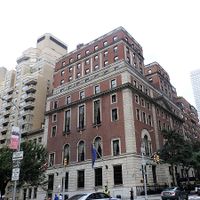Union League Club of New York
The Union League Club of New York is a prominent social club in New York. Its fourth and current clubhouse (opened February 2, 1931) is located at 38 E. 37th Street in the Murray Hill, a section of Manhattan. The club's first clubhouse was at 26 E. 17th. St. (1863), the second clubhouse was at Madison Avenue and E. 26th Street (1868), the club then moved to Fifth Avenue and E. 39th. St. (1881), where it remained until the move to the present building.
Union League clubs, which are legally separate but share similar histories and maintain reciprocal links with one another, are also located in Chicago and Philadelphia. Defunct Union League Clubs were located in Brooklyn, New York, and New Haven, Connecticut.
History
The club dates its founding from Feb. 6, 1863, during the (United States) Civil War. Tensions were running high in New York City at the time, as much of the city's governing class, as well as its large Irish immigrant population, bitterly opposed the war and were eager to reach some kind of accommodation with the Confederate States of America. Thus, pro-Union men chose to form their own club, with the twin goals of cultivating "a profound national devotion" and to "strengthen a love and respect for the Union."
The Union League (also known as Loyal Leagues) was actually a political movement before it became a social organization. Its members raised money both to support the United States Sanitary Commission, the forerunner of the American Red Cross, which cared for the Union wounded following battles, and the Union cause generally.
It didn't take long for the club's enemies to make their displeasure felt with the new organization. On July 13th, 1863, just five months after the club's foundation and only days after receiving word of the twin Union victories at Battle of Gettysburg and at Siege of Vicksburg, the New York Draft Riots exploded right in the club's backyard. The Union League Club was high on the vandals' list of targets, but members kept them at bay by maintaining an armed vigil in the locked and barricaded clubhouse on East 17th Street, just off Union Square Park.
(see Draft Riots on Wikipedia)
A few months later, the members decided to make an unmistakable gesture that they had not been intimidated. The club decided to recruit, train and equip a U.S. Colored infantry regiment for Union service. The 20th U.S. Colored Infantry was formed on Riker's Island in February 1864. The next month, it marched from the Union League Club, down Canal Street, and over to the Hudson River piers to embark for duty in Louisiana. In spite of numerous threats, the members of the Union League Club marched with the men of the 20th and saw them off. During World War I, the club sponsored the 369th Infantry, the famed Harlem Hellfighters, which was commanded by William Hayward, a club member.
During post-Civil War Reconstruction, Union Leagues were formed all across the South. They mobilized freedmen to register to vote. They discussed political issues, promoted civic projects, and mobilized workers opposed to segregationist white employers. Most branches were segregated but there were a few that were racially integrated. The leaders of the all-black units were mostly urban Blacks from the North, who had never been slaves. Foner (p 283) says "virtually every Black voter in the South had enrolled." Black League members were special targets of the Ku Klux Klan's violence and intimidation, so the Leagues organized informal armed defense units.
After the end of Reconstruction, the Union League Club of New York devoted itself to civic projects and clean government. It and its members helped to found the Metropolitan Museum of Art, and built the Statue of Liberty and Grant's Tomb.
Membership
The club has always promoted clean government and public-spiritedness. Many of its early members, notably cartoonist Thomas Nast, were instrumental in breaking William Marcy "Boss" Tweed's political organization. (Interestingly, a future club president, Elihu Root, served as one of Tweed's defense counsels.) Manhattan District Attorney and club member Charles S. Whitman used the privacy afforded by the club to secretly interview witnesses during his investigation of the case that sent NYPD Lt. Charles Becker to the electric chair in 1915 for murdering Manhattan gambler, Herman Rosenthal. Whitman was elected New York Governor as a result.
Long a men's club, it decided to admit women in the 1980s. Faith Whittlesey, President Reagan's Ambassador to Switzerland was the first female member (1986). Women now play prominent roles in the club's leadership including the Board of Governors, the Admissions Committee, the Public Affairs Committee, and the House Committee.
Two presidents, Theodore Roosevelt and Chester Alan Arthur were members of the club prior to entering the White House. Former presidents resident in New York, notably Ulysses S. Grant and Herbert Hoover, were active members.
Theodore Roosevelt was blackballed when he first applied for membership in 1881. Following the sudden deaths of his wife and mother in 1882, however, he was offered membership and accepted. After running on the Bull Moose Party ticket in 1912, Roosevelt was persona non grata at the club for several years, being welcomed back after the United States entered World War I.
George H. W. Bush and Barbara Bush, Margaret Thatcher, Brent Scowcroft, Sandra Day O'Conner, Henry Kissinger, Antonin Scalia, H. Norman Schwarzkopf, and Neil Armstrong are all Honorary Members.
The club has a strong artistic tradition. Some artist-members in the 19th century contributed paintings to the club in lieu of dues, and these remain part of the club's collection today.
- Also see the page [ Union League Club of New York ] on Wikipedia
See also
- Gentlemen's club
- List of American gentlemen's clubs
- List of Australian gentlemen's clubs
- List of London's gentlemen's clubs
External links
Chat rooms • What links here • Copyright info • Contact information • Category:Root
